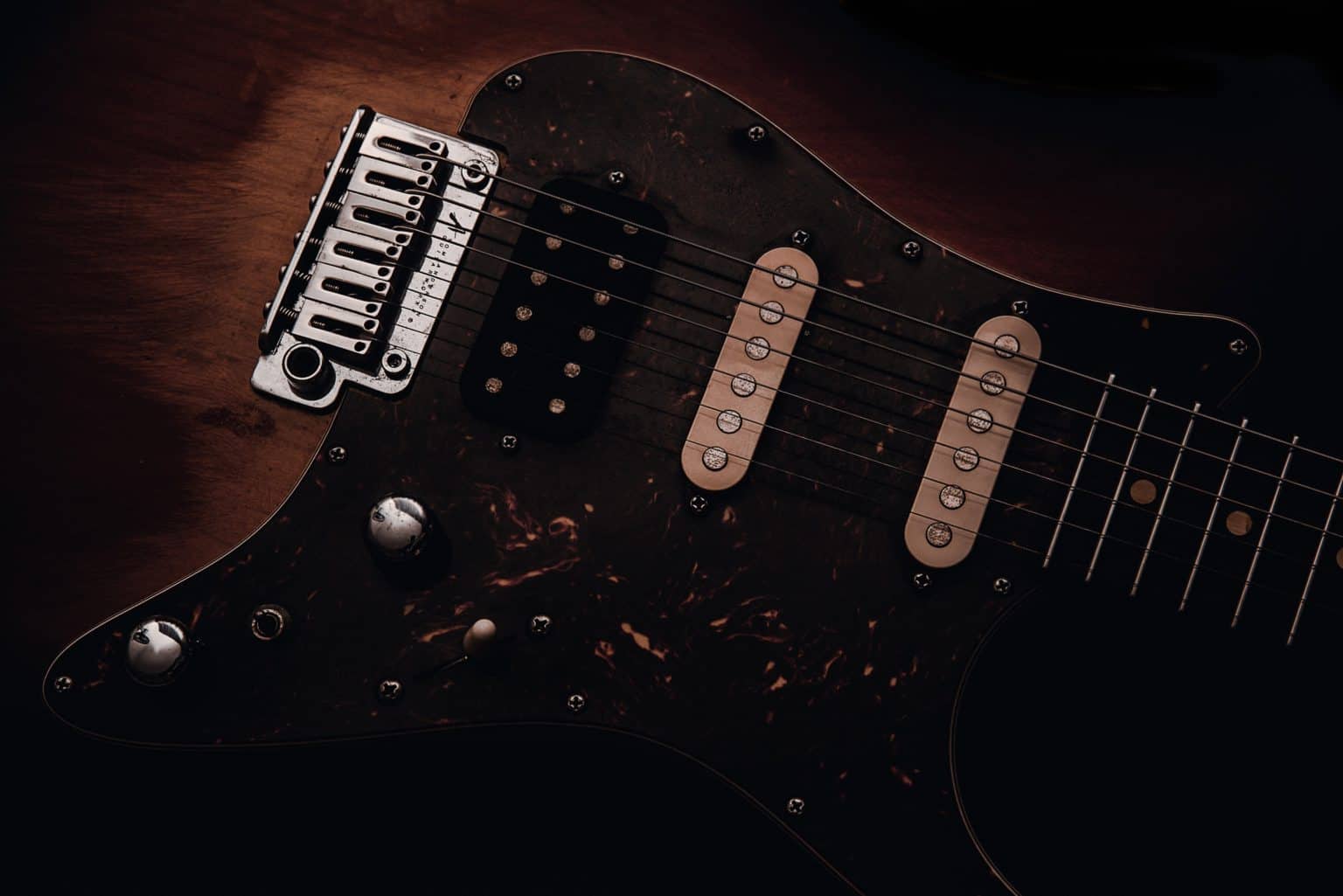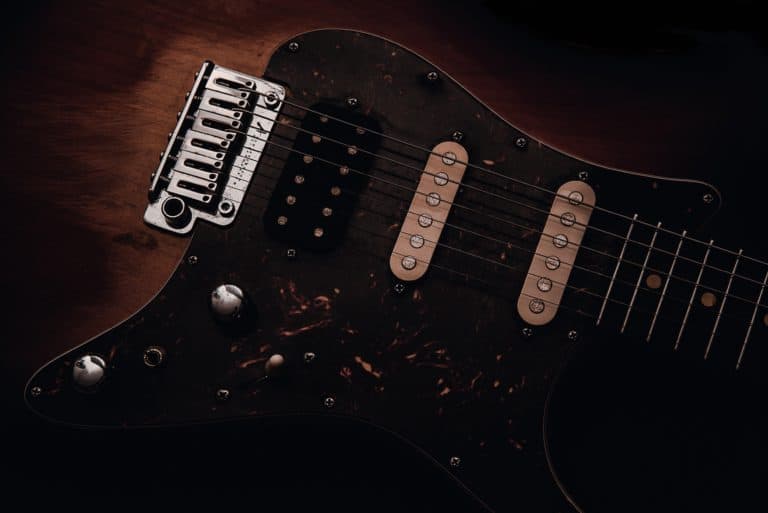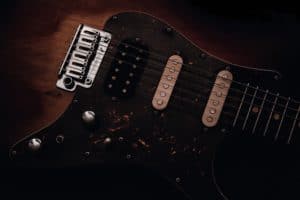Learning about the different types of guitar pickups is like learning about the different types of microphones. As artists, we need to be aware of our tools and how we can use them to achieve specific results.
You’d be surprised to find out how important it is to use the CORRECT combination of guitar pickups. If you haven’t had the luxury of trying all of them, perhaps this guide can give you a taste of what’s out there! We’ll be exploring single-coils, P90s, humbuckers and more.
Single-coil guitar pickups
Before I developed an ear for disco, funk, r&b and soul music, I had only ever owned guitars with humbuckers. Studio musicianship classes at Vanier College required us to become seasoned musicians in a variety of styles.
As a guitarist, I quickly realized that certain tracks required specific guitar pickups to adhere to a particular style.
To illustrate this, my instructor (and mentor) Jacques Labelle lent me his “Squier Classic Vibe 50s Stratocaster”. Hearing the results, I was immediately convinced to purchase one of my own using my local classifieds.
Sound profile of single-coil pickups
In essence, single-coil pickups are “bright”, “thin” and “focused” when compared to humbuckers. If you want to hear an example, listen to ANY funk guitarist as they mostly use a Stratocaster-type guitar.
Compared to other pickup configurations, the pickup configuration of a Stratocaster-type guitar provides that signature “chuck”.
Instruments that use single-coil pickups
Stratocaster-type guitars are famous for their triple single-coil pickup configuration, but they are not alone. Instrument pickups come in a variety of shapes and sizes, but had you ever considered combining them?
For example, Telecaster-type guitars can use a single-coil in the bridge, but a P90 pickup in the neck. There are even certain Stratocaster-type guitars that use a humbucker pickup in the bridge.
The possibilities are endless, but each type of guitar can potentially use some form of single-coil pickups. I personally own a “Danelectro DC 59 Reissue” that uses two “lipstick” pickups which are in fact, single-coils.
- Stratocaster-type
- Telecaster-type
- Jaguar-type
- Danelectro-type
- Rickenbacker-type
Musical styles that use single-coil pickups
In my opinion, single-coils can handle clean to lightly-distorted signals, but not heavily-distorted guitar amplifiers. Part of the reason is due to their inherent 60/50 cycle “hum”, but they aren’t “beefy” enough to handle too much gain.
In other words, single-coils are GREAT for rhythm guitar parts on disco, funk, r&b and soul tracks. You can also use them for soloing (like Jimi Hendrix did), but you’ll have to control the inevitable feedback loops.
- Disco
- Funk
- R&B
- Soul
- Rock
Let’s Talk About the Different Pickup Positions
You’re probably familiar with the 5-way selector switch on Stratocaster-type guitars, but we need to MASTER it. Using the wrong pickup position can completely ruin a track, so let’s go over each one.
- Position 1 (closest to the floor) – In this position, we’re only using our “bridge” pickup and the result is a “bright” tone. This position is great for “palm muting” and “popcorn” guitar parts.
- Position 2 – In this position, we’re using a combination of our “bridge” and “middle” pickup which cancels any “hum”. This position is great for rhythm guitar parts and features the signature “quack” (brighter).
- Position 3 – In this position, we’re only using our “middle” pickup and the result is a “vocal” tone. This position is great for lead guitar parts as it has the best harmonic-response.
- Position 4 – In this position, we’re using a combination of our “middle” and “neck” pickup which cancels any “hum”. This position is great for rhythm guitar parts and features the signature “quack” (darker).
- Position 5 (closest to the ceiling) – In this position, we’re only using our “neck” pickup and the result is a “dark” tone. This position is great for lead guitar parts that require a little more “thickness”.
Guitars that have two pickups installed use a 3-way toggle switch which eliminates positions 3 and 4. It is also worth mentioning that when single-coils are on their own, they produce can produce a lot more “hum”.
The best way to tame single-coil “hum” is by copper shielding your electronics (the results are stunning).
P90 guitar pickups
I still remember the day when I discovered that there was ANOTHER type of guitar pickup other than single-coils and humbuckers. I Want You (She’s So Heavy), a song by the Beatles off Abbey Road, was one of the last projects I completed with my studio musicianship class.
Everything was nearing completion, but we were still missing John Lennon’s incredibly tasteful guitar solo which I had just finished transcribing.
My instructor (and mentor), Jacques Labelle, was explaining to me that in order to get the TONE, I needed to use a P90 guitar pickup. To make me HEAR the difference, he brought in his vintage Epiphone Casino, like the one John Lennon used on the recording.
The difference between P90 and single-coil guitar pickups
As it turns out, the P90 pickup is technically considered a single-coil, however, they sound COMPLETELY different. The main reason for this difference in tonal characteristics is the height and the width of the bobbin used to wind the wires inside the pickup.
The bobbins of a P90 pickup are shorter and wider, which is why they look like jumbo-sized single-coils. The result is a pickup with a fatty, creamy and buttery tone with rich harmonic content.
Another important difference to take notice of is that P90 pickups use bar magnets under their polepieces while traditional single-coils use rod magnets as their polepieces. In other words, you can think of a P90 as somewhat of a hybrid between a humbucker and a single-coil pickup.
Since the P90 is technically a single-coil, it shares the same sensitivity to 60/50 cycle hum as traditional single-coils.
The different types of P90 pickups
Unlike single-coils and humbuckers, P90s come in a variety of shapes and forms to accommodate different guitar bodies. We’ll be looking at these 3 variations, but only one of these actually SOUNDS a little different than the others.
- Soap Bar – The first P90 pickups released by Gibson were called “soap bar” due to their creamy white finish and resemblance to an actual bar of soap. This particular variation of the P90 was meant to accommodate Les Paul and SG body types.
- Dog Ear – As Gibson began implementing P90 pickups into more of their guitars, they needed to create a casing to accommodate models such as the ES-330 and the Casino. These were called “dog ear” due to their resemblance to dog ears.
- Humbucker – Recently, manufacturers have started producing P90 pickups with the dimensions of a humbucker. These actually sound a little different since they are smaller, but they are great for replacing a humbucker without modifying your guitar’s body.
In essence, the only variation of the P90 pickup that sounds a little “thinner” is the humbucker. I personally installed a Lollar P90 for Humbucker in my Telecaster and couldn’t be happier with the results!
If you’re still wondering which styles of music P90 pickups are best suited for, keep reading as the next section will cover this in-depth.
Musical styles that use P90 pickups
Due to their percussive overtones, rich harmonics and excellent low-mid frequency-response, P90 pickups have been favoured by a variety of musicians. Whether you’re playing blues, country, jazz, rock or even punk, you can find a way to fit a P90 in there.
As I mentioned earlier, these pickups are a hybrid between humbuckers and traditional single-coils so you’re getting the best of both worlds.
I personally find they sound best in the neck position, but not so much in the bridge (maybe they would for punk?). I ABSOLUTELY love these pickups for playing anything to do with chords (especially those jazzy chords) and for leads with some SERIOUS character.
However, I would never use these babies for funk as they are too “heavy” for those kinds of guitar parts. Also, please avoid using TOO much distortion with a P90 pickup as they do not take it well and will lose a lot of their best attributes.
Make your P90 pickups sound amazing!
I only found out about P90 pickups in the last few years believe it or not, but in this short amount of time, I believe I have perfected TWO of my own signature tones. As a bonus for getting this far, I will share them with you right now!
- Ultimate “Rhythm” Guitar – To achieve my signature “rhythm” tone, you need a Telecaster with a single-coil in the bridge and a P90 in the neck. Combine these two pickups together to eliminate any “hum” and open your ears for some serious aural velvet!
- Ultimate “Lead” Guitar – To achieve my signature “lead” tone, you need any guitar equipped with a P90 in the bridge, a good tube amplifier and an Ibanez Tube Screamer (TS808). Introduce a little bit of overdrive, but not too much; just enough to get some “grit” out of your P90s!
What I love most about P90 pickups is that they sound GREAT on their own and require very subtle modifications to make a BIG difference. Treat these pickups with love and they will love you back.
If you’re considering replacing one of your pickups for a P90, check out Lindy Fralin, Jason Lollar and Kent Armstrong as they make some of the BEST.
Humbucking guitar pickups
Electric guitar pickups have always fascinated me… They can capture mechanical vibrations by producing a “magnetic field” around your strings.
If you’ve used electric guitars equipped with single-coil pickups, you know how “noisy” they can get at times.
Electromagnetism may be a thing of the future, but it does have its drawbacks. For instance, your electric guitar’s pickups can be quite sensitive to electromagnetic interference.
In 1956, Gibson began incorporating an early model of the humbucker pickup (PAF) on some of their guitars. Due to their “noise-cancelling” properties, they were sought after by guitarists to overcome “60 cycle hum”.
However, the creation of this pickup also provided musicians with an entirely new palette of colours to choose from.
Dealing with electromagnetic interference
Instrument pickups are quite sensitive to electromagnetic interference, but there’s not much we can do about that. Every appliance that is powered via “alternating current” has the potential to introduce “noise” into your signal.
Here are just a few examples…
- Transformers
- Dimmer switches
- Computer screens
- Fluorescent lightbulbs
Depending on your power-line’s frequency, you will hear a different “pitch” associated to the “hum” you experience (it’s usually 60 Hz).
How do humbuckers work?
In essence, humbuckers (also referred to as dual-coils) are actually a combination of TWO single-coil pickups. It’s a little more complicated than that, so bear with me as I get into the technical aspects of humbucking.
Simply combining TWO single-coil pickups would not give us “noise-cancelling” properties on its own. The first thing we should know about humbuckers is that their coils are in “reverse polarity” with each other.
What this means is that one coil’s “positive pole” is facing the string while the other’s “negative pole” is facing the string as well.
The next thing we need to consider is that a humbucker’s coils are wound in reverse to one another. Basically, one coil is wound clockwise (“ground” to “hot”) and the other is wound counter-clockwise (“hot” to “ground”).
As a result, the “noise voltages” will get cancelled out while the “signal voltages” will be summed. Its amplitude will also be doubled.
Did you know that you could achieve all of this without a humbucker?
If we use a Stratocaster-type guitar as an example, selecting positions 2 or 4 will also produce this “noise cancelling” property. We’re still combining TWO single-coils, except these ones are further apart from one another.
The different types of magnets
One of the main elements of a guitar pickup is not only the magnet, but the TYPE of magnet. That’s right, a humbucker’s magnet can be assembled with a variety of different metals and they all produce a unique “tone”.
In general, humbucker pickups tend to sound “fatter” and “darker” than single-coils.
However, there are a variety of different magnet types ranging from Alnico (aluminum, nickel, copper) to Ceramic which all produce slightly different sounds.
- Alnico II – This magnet produces the lowest output. It’s characterized by its “warmth” and “smoothness”.
- Alnico V – This magnet produces a higher output. It provides a tighter “bottom-end” along with a “cut in the mid-range”.
- Alnico VIII – This magnet produces the highest voltage in the Alnico category. It’s a little “warmer” than ceramic, but provides a lot of “presence in the mid-range”.
- Ceramic – This magnet usually produces the highest output. It’s characterized by its “brightness” and excellent “transient response”.
I hadn’t really paid much attention to this until recently, but it makes a HUGE difference. Think of these as different types of microphones, they all have a character that could lend itself to particular genres of music.
Passive vs active humbucker pickups
Years after the discovery of humbuckers, “active” humbuckers began to be introduced to the public. Models such as the EMG 81 have more “bite”, more output and improved string separation.
From my personal experience, “active” pickups do not sound as “natural” as passives, but what do I mean by string separation?
If you pay close attention, you’ll notice that playing a chord will not give you the same degree of note separation as a piano. With “active” pickups, I was able to discern EVERY note of a chord with much more clarity, but this must vary according to the quality of the pickup.
As it turns out, metal guitarists usually prefer actives (I didn’t), but they do have their place when it comes to intricate jazz chords in my opinion. You’ll need to try both for yourself to hear the difference, so pay your local guitar shop a visit!
The right guitar pickup for the job
I hope you’ve now become familiar with the different types of guitar pickups. It’s one thing to read about them, but I encourage you to go out and try them for yourself.
Having at least one of each type should be your next objective!
I’ve been in situations where the pickup configuration I was using simply wasn’t giving me the results I needed. There’s only so much we can do with post-processing effects.
If you have any questions, leave me a comment!








